Dave and my introduction to Blue Hole Canoes
In the winter of 1976, I was a freshman at University of North Carolina at Wilmington. One night, I attended the local Sierra Club meeting. The hot topic at the time was the protection of the New River, a river I’d paddled and felt I should become involved. I don’t remember much of the program, but I did meet Dave Benny that evening. Dave was close to twice my age, and an engineer at Dupont. He had recently purchased a Blue Hole canoe. Learning I also had a canoe (It was my first major purchase when I was sixteen), and had paddled several rivers in Southeast North Carolina, David picked my brain. Over the next six or seven years, until I left that part of the state, Dave or I would lead many of the canoe trips offered by the Wilmington chapter of the Sierra Club.
The Unique Blue Hole Canoe
Dave’s Blue Hole was a unique canoe. I don’t remember why he decided to purchase a boat built for white water to run in the black water rivers in the eastern half of the state. But I was impressed how well it handled in narrow winding streams where there were lots of logs just under the surface. Those unseen logs would often catch the keel of my Grumman canoe. The Blue Hole had a flat bottom which helped it float them. Its design also allowed the paddler to quickly turn and to move easily across a fast current, a benefit when paddling in a swampy area during high water where the water flow wants to pull your boat out of the channel and into the swamps.
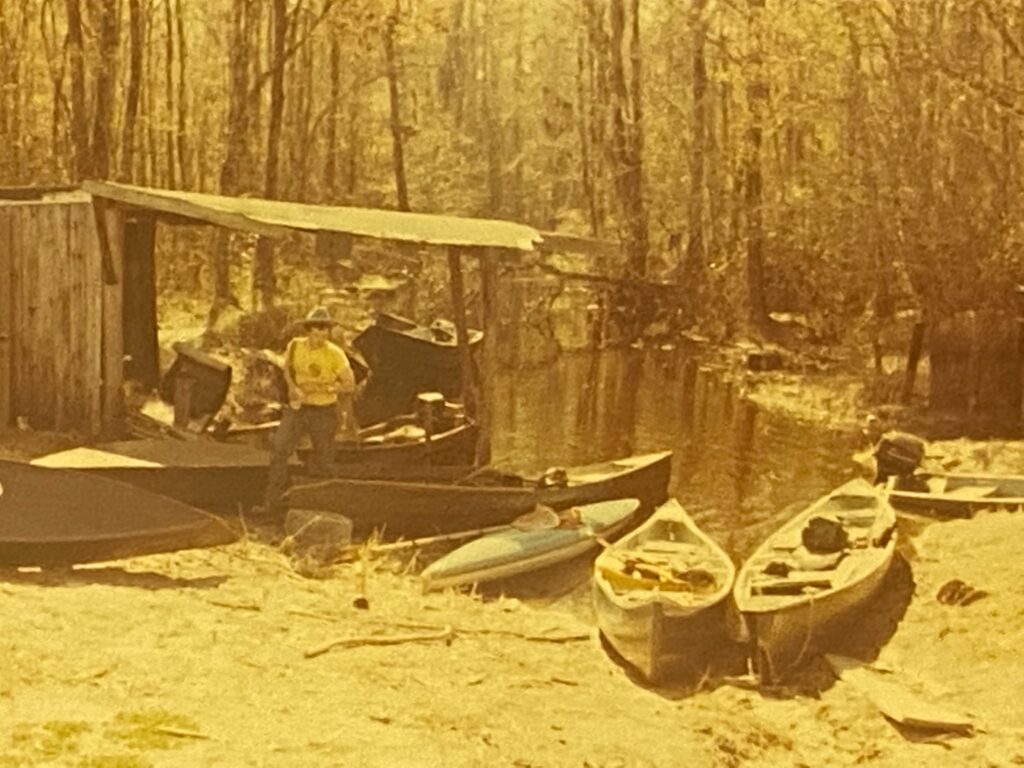
However, when the river widens and the wind picked up, the flat bottom made the Blue Holes less desirable. One had to paddle harder to keep the boat tracking properly. Many of our trips would begin on smaller creeks and then end up on larger rivers, where Dave and whoever was paddling in his bow had to work harder than the rest of us.
The Blue Hole was made of a new substance called Rolex ABS. It was much stronger than fiberglass and a lot quieter than aluminum, like the Grummans. In my boat, any bump on a submerged log or a drop of a paddle or water bottle into the boat would be announced to everyone. Dave’s boat was much quieter.
Dave and the finer things in life
Dave and I didn’t paddle together much. We were generally in our own canoes, with each of us having another participant in our bow. But on occasion, the two of us would go out together to scout a new river or creek. Then, we’d often take Dave’s canoe. Dave seemed to have all the cool toys. As a middle-aged single man, he could afford such things. In addition to his canoe, he was the first person I knew with a Leica, a German camera known for its superior optics. He also purchased a Sea Gull 1.2 horsepower outboard motor. This British designed motor, I would later learn, was popular among sailors to power dinghies and rafts to and from a mooring.
Dave obtained the Sea Gull motor so we could take a canoe upstream to check out new streams. After motoring upstream, we’d paddle back down to our vehicle. One such stream was Colly Creek, which flows into the Black River. That little motor pushed us upstream easily. But there were lots of weeds in the stream, which kept tangling up the prop and causing the sheer pin to snap. Dave, however, came prepared. We became very proficient at replacing sheer pins that day and when we had no more pins, we were in sight of a bridge we could use to launch from. It was time to turn around. We paddled with the current to our waiting vehicle at a bridge just downstream of the confluence with the Black River. Colly Creek became a favorite paddling stream, and I must have run that creek a dozen times.
Leaving Eastern North Carolina and acquiring a Royalex Canoe
I left Eastern North Carolina early in 1984 and lost contact with Dave. In one of our last trips together, he had invited a woman along. I heard they later married. For a few years, I would occasionally hear about him from my brother who was also an engineer with Dupont, but in another factory. But then he retired and that was many years ago.
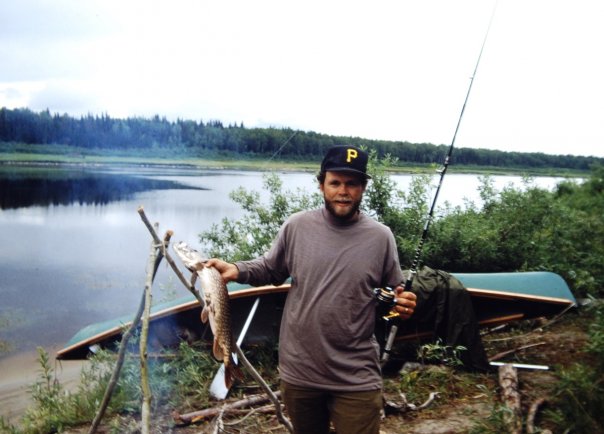
As for my old Grumman Canoe, it was stolen in 1985. I would replace it with a Mad River Explorer. Like the Blue Hole, it’s also an ABS Royalex boat. However, instead of a totally flat bottom like the Blue Hole, it has a rocker bottom which allows it to track better downstream and on lakes. I still have that boat. I have paddled it in rivers in nine states as well as northern Ontario where I paddled to the James Bay. I have replaced the wooden gunnels twice, and it’s still a good paddling canoe. I must continue caring for that boat for they no longer make ABS Royalex.
Paddling with Bill in one of his Blue Holes
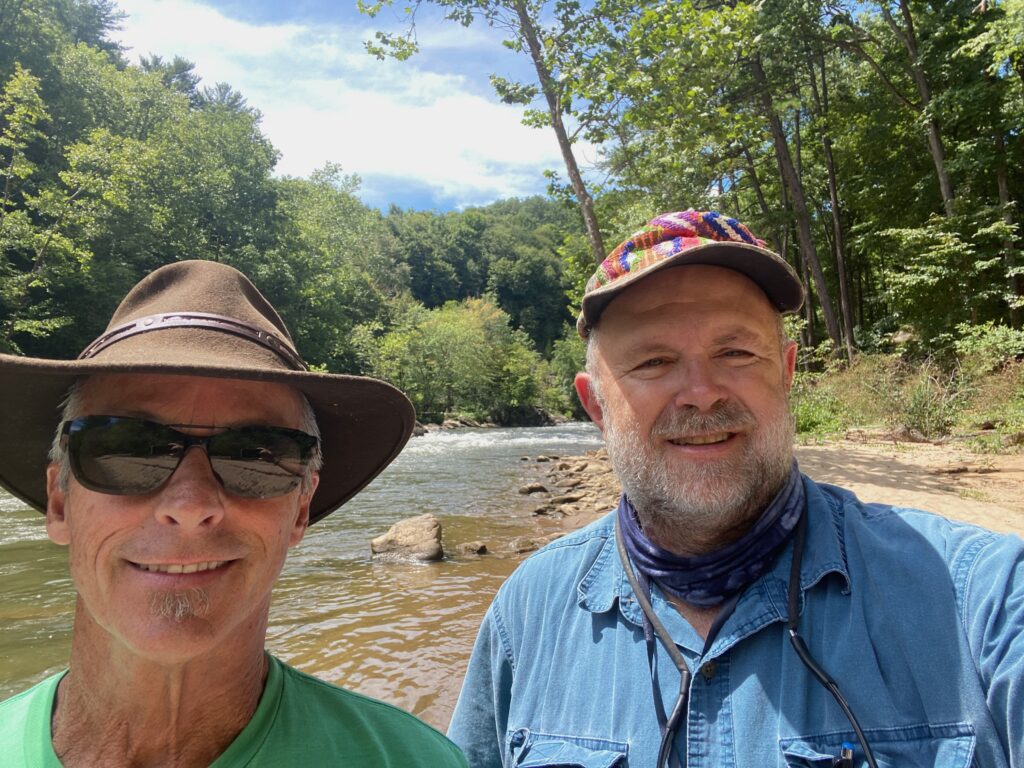
Two weeks ago, when I was at Montreat, a Presbyterian Conference Center in Western North Carolina, I met up with another old friend. Bill and I had been a part of the team who ran the youth program at First Presbyterian Church in Hickory NC. We both paddled a lot, but only once made one trip together, that I recall, on the Henry River (where parts of the Hunger Games would be filmed decades later). Bill, who has lived in Asheville for over 30 years, suggested we paddle the Tuckaseegee River. Bill’s canoes have multiplied. He now owns a trailer full and they’re mostly Blue Holes. On this day, he brought along a tandem boat which we paddled together.
Meeting Bob Lantz

We made our way down the river, through rapids named the 1st Hole, the 2nd Hole, the Slingshot. A short bit after running the Double Drop rapid, Bill suggested we drop in and see a friend of his. We found Bob Lantz at his cabin on the river and spent some time sitting out on his porch drinking a beer and talking. Bob was one of two designers for the Blue Hole canoe. After talking to him that day on the river, I decided that I needed to read his book. Doing so, I realized that Dave’s canoe would have been one of the earlier boats built by the company, only a few years after its founding.
Sadly, Bob no longer paddles. He’s had a couple of knee replacement surgeries and cannot kneel in a canoe. But he does get to enjoy being on a beautiful river and watching canoes, kayaks, and rafts float by.
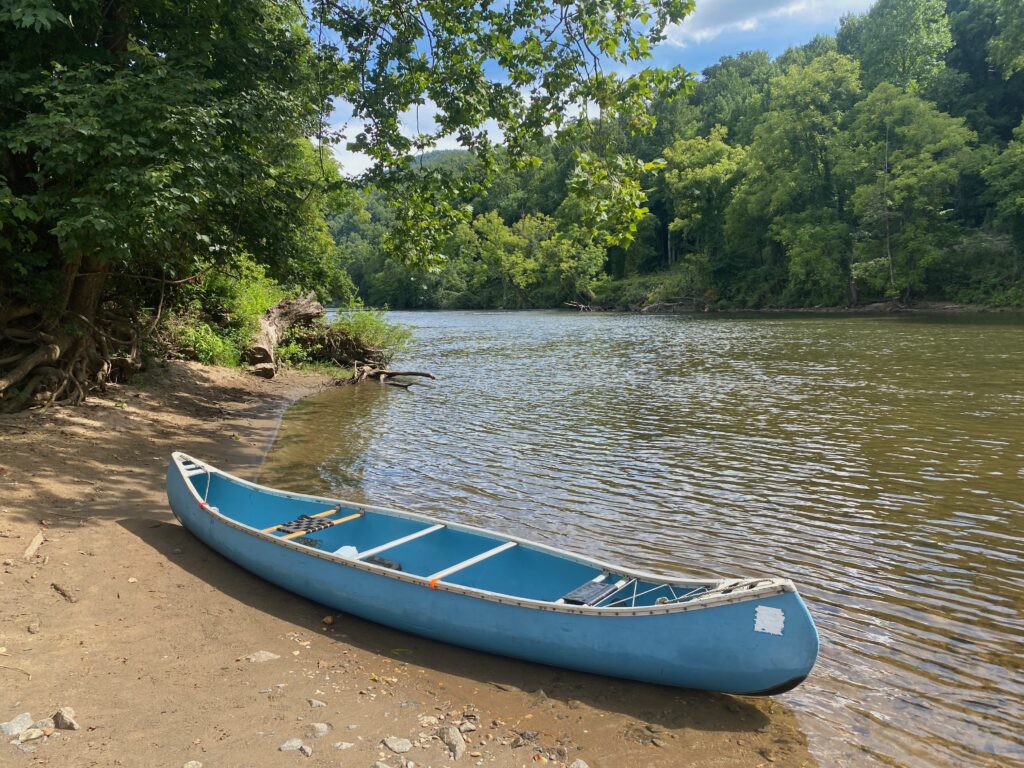
###
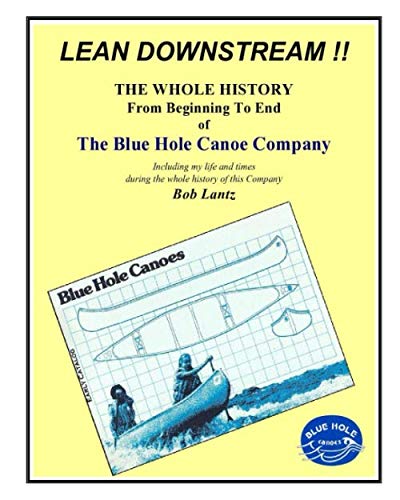
Bob Lantz, Lean Downstream!! The Whole History from Beginning to End of the Blue Hole Canoe Company
(Bob Lantz, 1979), 231 pages with many photos and diagrams.
This book contains many moving parts. It’s part memoir but includes engineering and business details of canoe construction along with bits about how to paddle and work to save rivers in Tennessee. Combining these elements, the reader learns much about the growth of canoeing as a recreation activity in the 1970s and 1980s. The author appears upfront with his honesty, admitting when he made mistakes. And his mistakes include a superior attitude of how to paddle before being taught proper techniques as well as business and personnel blunders while running a company.
The book jump around a lot. However, the author warns the reader about this at the beginning. Lantz takes a thread and runs with it (such as the business of building canoes) then backtracks to fill in his personal details. He also tends to blatantly “foreshadow” what will happen in his writing by telling his readers he’ll get to it. However, the book is easily read. Lantz writes in a conversational style, not the technical style one expects from engineers. This less formal style seems to work well and serves the author’s purposes.
The author claims this is the “whole history” of the Blue Hole Company. However, I couldn’t help but assume some things are left out. But such is the nature of any writing as we can’t cover or report on everything. I would suggest the book is a history of the company through the eyes of one of its major players.
This book is also a history of the personal life of the author. I must admit, I felt sorry for him. Lantz was suddenly single and middle aged, sitting by his wood stove on winter nights in an old Tennessee farmhouse. When I visited his cabin on the Tuckasseegee, I admired his stove. He seemed appreciative and said it was his second Jotul wood stove. His first one eventually burned out the sidewalls trying to heat his house on the Cumberland Plateau in Tennessee. Reading the book, I realized the stove is a minor character in Lantz’s story.
That said, I was impressed with what Bob, a former aerospace engineer, and friends were able to do. They developed a company that radically changed the sport of white-water canoeing. From the idea to build canoes out of Royalex, to their design and develop of aluminum gunnels (purposely using low-tempered aluminum) and thwarts, Blue Hole was a pioneer in the canoe industry. The company lasted for fifteen years (1973-1988). Sadly, internal struggles seemed to sink the company. When friction between partners increased, the bank called the loan and the company liquidated.
I recommend this book to those interested in the development of canoeing in this country. Even if you don’t read it all, the book has great photos. As a warning, I doubt those uninterested in canoeing and rivers would find much enjoyment from the book. I am also grateful to the role the author and the company played in protecting several rivers in the Southeast.
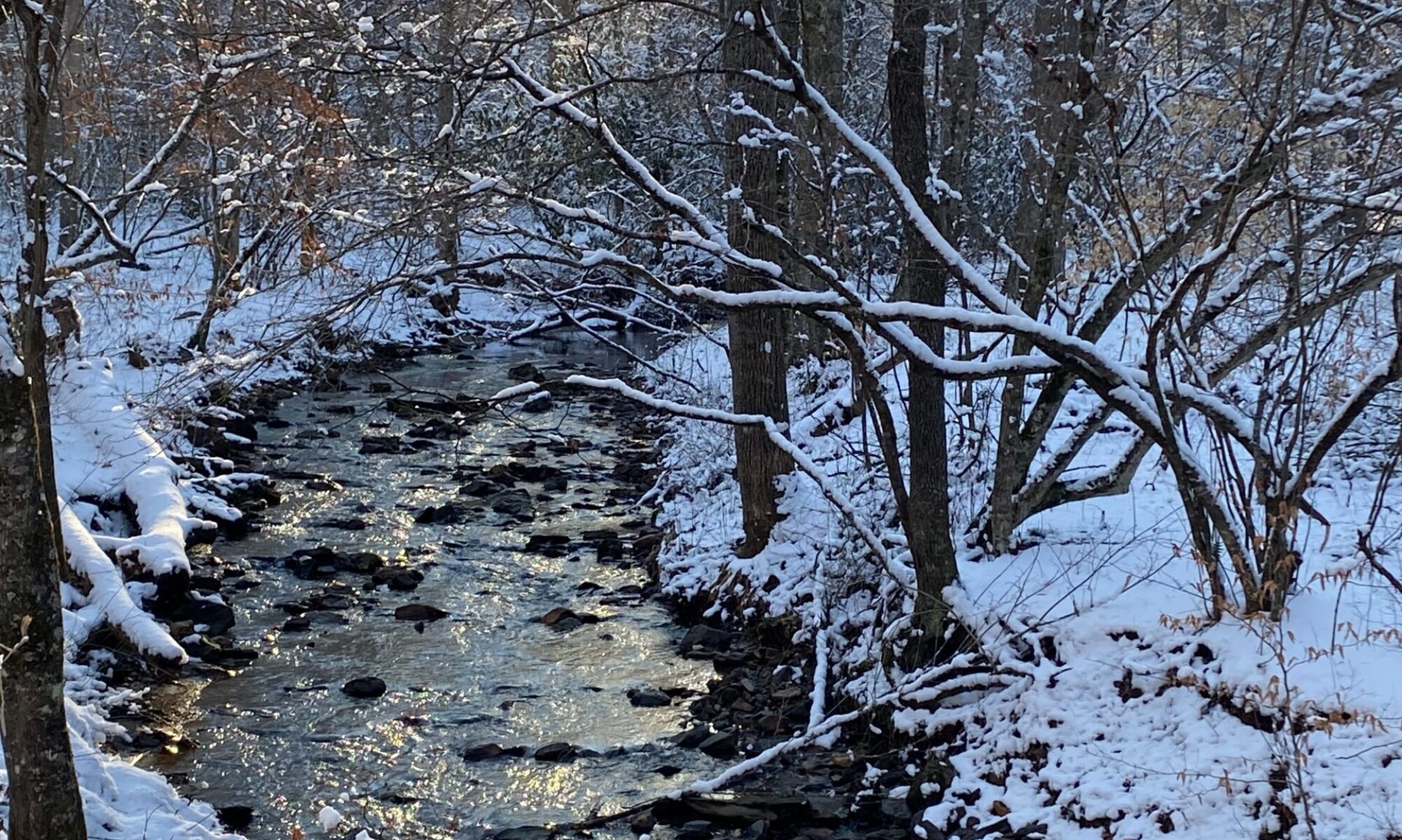
Such an interesting post, Jeff. I haven’t gone canoeing in decades. I’ve only canoed on lakes. You certainly have had many aquatic adventures!
I’m drawn to water!
For some reason, when I try to comment, it doesn’t end up posting?? I will try again:
I wasn’t aware of different styles of canoes, but I’ve only been canoeing twice in my life and kayaking once. Enjoy the cooler weather!
I am sorry for your issues. I have that on some sites and wish I knew how to fix it.
I’ve never heard of that kind of canoe, not that I know much about canoes. lol
Sure sounds like you had some good times though.
Interesting people 😀
I’ve never been in a canoe but if I ever am, I want a Blue Hole.
Thanks for stopping by today:)
Enjoyed reading your post, and what a fabulous photograph “Bill’s Blue Hole at the Take-out on the Tuckaseegee River” is 🙂
All the best Jan
Notice that in the photo, Bill had already removed his “low-carb” beer cooler 🙂
I had no idea there were names and types of canoes. Then again,I’ve been in one a total of two times.
The reason I have several types of kayaks is for different water! Canoes are the same way. Generally shorter canoes are solos, and the type of bottom and keel depends on the type of stream.
That was pretty interesting. I know nothing about the boats or history, nor do I paddle down streams, but I was caught up in the enthusiasm and energy of those who did. I even clicked through to the book!
BTW, here’s the link for anyone else intrigued: https://www.amazon.com/LEAN-DOWNSTREAM-HISTORY-Beginning-Company/dp/1089182325
There is something freeing about being on the water with a boat, especially ones that don’t have a loud motor! Glad you captured some of the excitement.
Enjoyed the story you shared, Jeff. All I could think is how sore I would be from this trip. In my limited experience on a kayak, I discovered muscles that I didn’t know existed the next day.
But if you keep paddling, you’ll develop those muscles. However, you do use different ones between kayaks and canoes.
What a great way to travel a river! I’ve never paddled a canoe, but I’ve kayaked and rafted. Seeing the world from the water is the absolute best. Loved this tale from your earlier days.
I have two kayaks and a canoe, and they’re good for different things. I would never paddle a canoe across large open bays like I do with my ocean kayak. But for rivers and for inland lakes, the canoe is great. And it can carry a lot of gear if paddling in the wilderness. Having done lots of backpacking and paddling, you see a lot more wildlife (except perhaps songbirds) from the water than from land.
I don’t recall ever being in a canoe before. (or a kayak, for that matter!) These days I stick with john-boats.
Jon boats are good, too, but don’t paddle nearly as easily as a canoe. They are best rowed (or motored)
We still have our Royalex canoes. I’ve heard the T-Formex canoes are even better than Royalex but I haven’t had a chance to paddle one yet.
By the way, I’ve only paddled a keeled canoe once when I rented an aluminum one for my boundary waters trip. All I can remember was that it was a bear to get turned around!
How heavy is T-Formex? In my trip into the Quetico (north of the Boundary Waters in Western Ontario, we rented Kevlar boats. They were so light, only 40 pounds for an 18 foot boat, but I wouldn’t want to take one through much of a rapid.
I don’t know the answer to your question. From what I have read, it is almost identical in everyway to Royalex only is has a glossier finish which some claim makes it slide through the water easier.
On my boundary water trip, the same one I paddles my only keeled canoe, I had a chance to carry another’s kevlar canoe. I had the same conclusion as you.
That was a good deal, carrying someone’s kevlar boat if they picked up your aluminum boat!
That sounds like an interesting wide-ranging book. It’s a long time since I’ve been in a canoe and I’ve never canoed white waters. But I loved the times I canoed on a Scottish loch and a Cornish river.
I would love to paddle across Scotland (probably in a sea kayak) from Port Williams to Inverness!